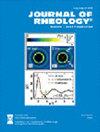具有永久和瞬态交联的双交联凝胶的断裂:瞬态交联松弛时间的影响
IF 3.2
2区 工程技术
Q2 MECHANICS
引用次数: 1
摘要
我们研究了含有少量共价键和大部分基于金属配位键(Ni2+或Zn2+)的动态键的聚(丙烯酰胺-co-1-乙烯基咪唑)双交联水凝胶[P(AAm-co-VIm)-M2+凝胶]的断裂性能。与先前对基于聚乙烯醇和硼酸盐离子(pva -硼砂凝胶)的具有较慢动态键的不同双交联水凝胶体系的研究不同,这些较快动态配位键的存在有两个主要影响:即使在高拉伸速率下,它们也能显著增韧P(AAm-co-VIm)-M2+凝胶,在这种情况下,动态键原则上应在裂纹尖端表现为共价键;在极低的拉伸速率下,它们也能增韧凝胶,在加载阶段,动态键是不可见的。我们提出了两种额外的分子机制来合理化P(AAm-co-VIm)-M2+凝胶的这种行为:我们假设快速交换的动态键与键断裂的特征时间相比仍然缓慢,因此即使在低加载速率下也能够分担共价键断裂的负荷。我们还认为存在寿命较长的动态键簇,它们在单轴拉伸中引入了与拉伸速率相关的应变硬化,并稳定并增加了裂纹尖端耗散区的大小,从而引入了与应变相关的耗散机制。本文章由计算机程序翻译,如有差异,请以英文原文为准。
Fracture of dual crosslink gels with permanent and transient crosslinks: Effect of the relaxation time of the transient crosslinks
We investigate the fracture properties of poly(acrylamide-co-1-vinylimidazole) dual crosslink hydrogels [P(AAm-co-VIm)-M2+ gels] containing a small fraction of covalent bonds and a majority of dynamic bonds based on metal coordination bonds (Ni2+ or Zn2+). Unlike a previous study on a different dual crosslink hydrogel system having slower dynamic bonds based on poly(vinylalcohol) and borate ions (PVA-Borax gels), the presence of these faster dynamic coordination bonds has two main effects: They significantly toughen the P(AAm-co-VIm)-M2+ gels even at high stretch rates, where the dynamic bonds should in principle behave as covalent bonds at the crack tip, and they toughen the gels at very low stretch rates, where the dynamic bonds are invisible during the loading stage. We propose two additional molecular mechanisms to rationalize this behavior of P(AAm-co-VIm)-M2+ gels: we hypothesize that fast exchanging dynamic bonds remain slow compared to the characteristic time of bond scission and are, therefore, able to share the load upon covalent bond scission even at low loading rates. We also argue of the existence of longer-lived clusters of dynamic bonds that introduce a stretch rate-dependent strain hardening in uniaxial tension and stabilize and increase the size of the dissipative zone at the crack tip, thereby introducing a strain-dependent dissipative mechanism.
求助全文
通过发布文献求助,成功后即可免费获取论文全文。
去求助
来源期刊

Journal of Rheology
物理-力学
CiteScore
6.60
自引率
12.10%
发文量
100
审稿时长
1 months
期刊介绍:
The Journal of Rheology, formerly the Transactions of The Society of Rheology, is published six times per year by The Society of Rheology, a member society of the American Institute of Physics, through AIP Publishing. It provides in-depth interdisciplinary coverage of theoretical and experimental issues drawn from industry and academia. The Journal of Rheology is published for professionals and students in chemistry, physics, engineering, material science, and mathematics.
 求助内容:
求助内容: 应助结果提醒方式:
应助结果提醒方式:


